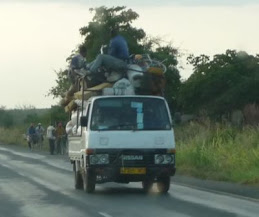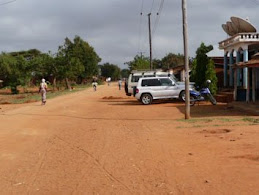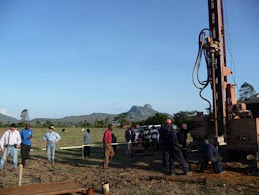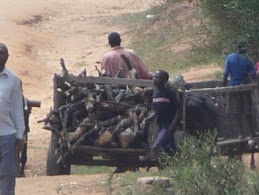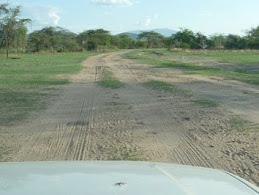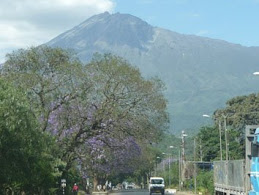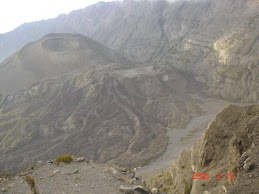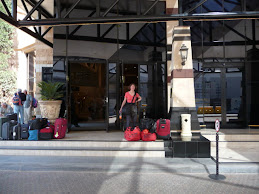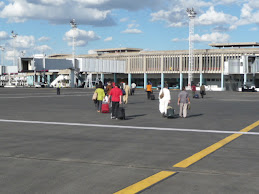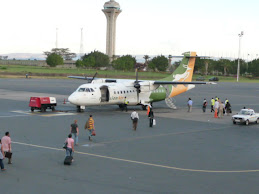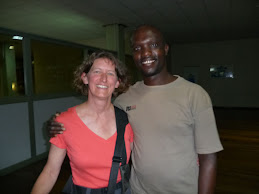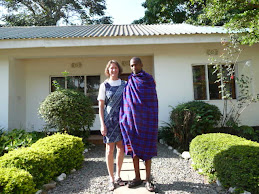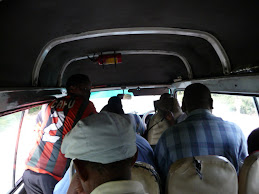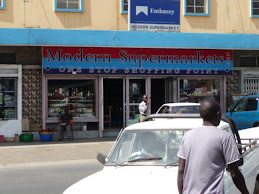Monday, November 17, 2008
We Have Mobility
On Friday this week we picked up the vehicle we had purchased. The dealer was kind enough to let us take it while we were waiting for the wired funds to come through. It was nice to drive home and not have to take the daladala van for once. It is a Mitsubishi Pajero GDI which is a smaller engine and shorter version of the Pajeros I knew in Australia. It is a 5 door vehicle, automatic, with 2H, 4H and 4L wheel drive with diff lock. Ramona christened her “Patty Pajero". Driving around brings another set of differences to what we are used to. There are a lot of people walking along the road all the time it seems so you have to watch out for them a lot more. The daladala vans seem to have their own rules so you have to watch them too. When you park in town a person comes around and puts a little ticket under your wiper. This lets you park there for TzS 200 for an hour. (About $0.20 US). When you go to leave is when you pay them as they come up to your vehicle asking for the payment, ie no parking meters are used. So we’ll have to learn to carry more small change around with us from now on. There are a lot of speed bumps are along the road to keep speed down and some are quite abrupt! They generally have pedestrian crossings on top of them, though on most, the white stripes are worn off hence you have to look carefully for pedestrians. (They are known as zebras here.)The speed limit between USA river 20 km east of Arusha and Arusha is 50 kph with sections at 30 kph. Other volunteers tell us there are speed traps all along the road.
Started Working on the Water Project
This past week we settled down into work more. We started off with a meeting with Max and some project managers who are involved in the water project at Gairo. The project aims to supply water points in 7 villages affecting about 2000 households. These households on average at the moment have only 6 litres of water per person per day and the people have to walk/travel 5 km for this every day. The project goals are to install 22 hand operated water pumps that will enable these households to access 25 litres per day per person and within a maximum walking distance of 500 m. Max had a draft of a request for quotes to be sent out to various drilling companies to ascertain their interest and ability to perform the required drilling. We took a copy of it and started modifying it somewhat based on our experience from our previous work in Australia. Max also gave us a report from a local but USA born guy, Larry, who has a company that does underground water searches. On Tuesday we had a meeting with Larry at a local hotel and spent about 1.5 hours talking to him about this project and how to work with drillers here. It was a very good meeting. On Wed we finalised the RFQ with Max and sent it out on Thursday. On Friday morning we met with two of the drillers after they had read the RFQ and had questions. One of them was a UK guy who has lived here for many years. He too had a lot of good advice for us on local conditions and what we would need to do to get the work done properly. On Saturday I sent out to the drillers some more information that Larry had put in his reports, to enable the drillers to access the work load more accurately.
While in town on Friday we bought some basic tools that we need on a current job at ADRA and expect to have a need for the Gairo project when we get there. We got them from a little store on a back street figuring they would be priced more for the locals there rather than the stores on the main street of town. It is funny how things are still priced as 5000 schillings or 10,000 schillings and nothing in between. Maybe as we are Mzungu.
At the campus we have a couple of projects on the go too. One involved taking down (well more of a controlled fall!) some 10 m poles and moving them up to the front by the main road where they are to be resurrected with some vertical banners on them promoting the campus with the baby home, the cottages and furniture operations. We are waiting on quotes for getting the banners made at the moment. The second project is to try to improve the water pressure into the cottages. The first method is to see if we can raise the height of the water tank. To do this first we have to test however if the water supply will have enough pressure to fill the tank at an extra 2 m of height. Now that we have the tools we will test this in the coming week.
While I was up the ladder trying to disconnect the water line into the tank, Ramona was helping one of the volunteers from the baby home who was working on a flyer. We had the software she needed luckily so she was using my computer with Ramona’s help.
While in town on Friday we bought some basic tools that we need on a current job at ADRA and expect to have a need for the Gairo project when we get there. We got them from a little store on a back street figuring they would be priced more for the locals there rather than the stores on the main street of town. It is funny how things are still priced as 5000 schillings or 10,000 schillings and nothing in between. Maybe as we are Mzungu.
At the campus we have a couple of projects on the go too. One involved taking down (well more of a controlled fall!) some 10 m poles and moving them up to the front by the main road where they are to be resurrected with some vertical banners on them promoting the campus with the baby home, the cottages and furniture operations. We are waiting on quotes for getting the banners made at the moment. The second project is to try to improve the water pressure into the cottages. The first method is to see if we can raise the height of the water tank. To do this first we have to test however if the water supply will have enough pressure to fill the tank at an extra 2 m of height. Now that we have the tools we will test this in the coming week.
While I was up the ladder trying to disconnect the water line into the tank, Ramona was helping one of the volunteers from the baby home who was working on a flyer. We had the software she needed luckily so she was using my computer with Ramona’s help.
Sunday, November 16, 2008
Mobile Internet
In anticipation of going to Gairo for the drilling and pump installations, we bought a USB modem for the computers. This connects to the phone company cell towers directly so you don’t have to go through anyone else’s ISP. We had a bit if trouble connecting it up as the phone company didn’t give instructions how to set up their network for it. But we got it going eventually after a visit to their office in Arusha again. It is advertised with a speed of 7.2 mbps which would be very fast, but we only are getting about 50 kbps from it. Slow but some connection is better than no connection we figured. The phone companies have their own power supplies so when the electricity goes off we will be able to use this modem and still connect to the internet. (But only while our laptops run on internal battery power).
Sunday, November 9, 2008
Meru Game Park Lodge
Yesterday we were taken by Max and his wife to a small lodge and park 5 km or so east of ADRA. The park is not far from the Kilimanjaro airport hence it is a place where tourists often stay on the beginning or end of their safari. The lodge is located within 33 acres of mature, well manicured gardens bounded on one side by the Usa River and on the other by the Animal Sanctuary. There is a viewing area to sit and watch the animals come up at feeding time. A keeper brings out food for the animals and birds there. So it is quite a good little show.
On view are zebras, ostriches, eland, water buffalo, a range of monkeys playing in trees and other large birds. The Saddle-bill stork was particularly interesting being so big about 1.2 m (4 ft) tall and with a bright coloured head.
On view are zebras, ostriches, eland, water buffalo, a range of monkeys playing in trees and other large birds. The Saddle-bill stork was particularly interesting being so big about 1.2 m (4 ft) tall and with a bright coloured head.
Arrived at ADRA
ADRA (Adventist Development and Relief Agency, http://www.adratz.org/) is the sponsoring partner organisation VSA has arranged for us to work with while in Africa. We arrived at the ADRA campus on Monday afternoon. It is a campus surrounded by a high wall for security purposes and with 24 hour security. We had great expectations of getting on the internet once here as they have a large wide area wireless ADSL network across the campus. The first day, we got on the internet for about 10 mins then it froze. We find out is it a general power outage. These are common it seems across the country as there is not the generation capacity to meet demand. I read in the paper that it was costing the Tanzanian government $2M a day for these power outages and lost productivity! ADRA have back up generators for the campus, however we found out their UPS’ back up battery had failed and with any power fluctuations from the generator, the UPS would disconnect but not reconnect. There is a Danish education school next door and they have a computer lab which Max’s wife said we could use. We went up there and it was OK but painfully slow, would freeze often. When we came back after dark the power was back on so the internet was up. So good to get connected again as our Australian affairs are backing up.
Thursday we caught a daladala into town to buy a replacement battery for the UPS, to look at a vehicle to possibly purchase and get groceries from the Shoprite store. The power was off most of the day in Usa and in Arusha we learned and the generator was on we returned. We replaced the battery and had webmail on internet that night.
There is a baby home on the ADRA campus run by Davona, Max’s wife, plus a set of cottages or roundels for accommodation for tourists or guests. One has an open plan kitchen dining area with TV with a satellite connection with channels like CNN, BBC news etc. The roundels are split down the middle making a separate accommodation on each side. (We had breakfast one morning at the same time CNN was on & heard USA president-elect Obama’s “acceptance” speech. Ramona did get to vote absentee before we left Melbourne so she was glad about that.) There is also a laundry on the other side of the dining roundel with washer and dryer. Plus a clothes line outside which we will mostly use I’m sure. We’ll be sharing the kitchen with any others (tourists, guests). All in all a good setup. We changed our roundel room around a bit to add a big table to set the computers, printer, phone charges up on etc, to make a good work station.
Also on the campus there is a furniture making section. They make nice wooden furniture for sale to various businesses and organisations. They make just about any piece it seems. Cupboards, dressers, beds, tables etc. Part of Ramona's project is to try and help further market the roundels and this furniture section to see if we can increase sales of these items for ADRA.
On his return from Nairobi last week, we met the Tanzanian ADRA director, Max. Max is from the USA but lived in Africa for the last 25 years and has worked with ADRA for quite a few years. He spoke to us about his plans and what we can get involved in. It was good to hear. We ended up chatting to him for about 2 hours about his projects. He is quite humorous, very friendly, and has some big plans, some good engineering ones too from mini hydro power generation, to water bore drilling and water supply to water deficient villages. Other plans he has are on human care, like aids prevention & education, coordinating the accounting side of the various orphanages around and orphan supplemental care. He has two big water projects on the go, one is for about 12 water wells and the other is 120 water wells. Both encompass other aspects like hygiene and education so the people get to use the water properly and not get sick at times. Another guy (from the USA), now coordinating a program in Zambia, is here at the moment as one of Max’s water projects is shared with him. He was all excited about VSA, he said “you mean I can get experienced people for almost free?” This discussion was a good beginning focus for us.
Thursday we caught a daladala into town to buy a replacement battery for the UPS, to look at a vehicle to possibly purchase and get groceries from the Shoprite store. The power was off most of the day in Usa and in Arusha we learned and the generator was on we returned. We replaced the battery and had webmail on internet that night.
There is a baby home on the ADRA campus run by Davona, Max’s wife, plus a set of cottages or roundels for accommodation for tourists or guests. One has an open plan kitchen dining area with TV with a satellite connection with channels like CNN, BBC news etc. The roundels are split down the middle making a separate accommodation on each side. (We had breakfast one morning at the same time CNN was on & heard USA president-elect Obama’s “acceptance” speech. Ramona did get to vote absentee before we left Melbourne so she was glad about that.) There is also a laundry on the other side of the dining roundel with washer and dryer. Plus a clothes line outside which we will mostly use I’m sure. We’ll be sharing the kitchen with any others (tourists, guests). All in all a good setup. We changed our roundel room around a bit to add a big table to set the computers, printer, phone charges up on etc, to make a good work station.
Also on the campus there is a furniture making section. They make nice wooden furniture for sale to various businesses and organisations. They make just about any piece it seems. Cupboards, dressers, beds, tables etc. Part of Ramona's project is to try and help further market the roundels and this furniture section to see if we can increase sales of these items for ADRA.
On his return from Nairobi last week, we met the Tanzanian ADRA director, Max. Max is from the USA but lived in Africa for the last 25 years and has worked with ADRA for quite a few years. He spoke to us about his plans and what we can get involved in. It was good to hear. We ended up chatting to him for about 2 hours about his projects. He is quite humorous, very friendly, and has some big plans, some good engineering ones too from mini hydro power generation, to water bore drilling and water supply to water deficient villages. Other plans he has are on human care, like aids prevention & education, coordinating the accounting side of the various orphanages around and orphan supplemental care. He has two big water projects on the go, one is for about 12 water wells and the other is 120 water wells. Both encompass other aspects like hygiene and education so the people get to use the water properly and not get sick at times. Another guy (from the USA), now coordinating a program in Zambia, is here at the moment as one of Max’s water projects is shared with him. He was all excited about VSA, he said “you mean I can get experienced people for almost free?” This discussion was a good beginning focus for us.
Mt Meru
Just north of Arusha a few miles is Mt Meru. It is 4,565 m (15,000 ft) high and the 5th highest mountain in Africa. An impressive old volcano that last erupted a long time ago. The lower slopes are covered in forests and fruit plantations now days. The mountain causes a large rain shadow around the region which is why Arusha is where it is. The lands around are quite fertile compared to areas further away which are desert effectively. The water supply for Arusha and surrounds comes from the catchment off Mt Meru. The mountain is quite pretty to see though it is often hidden clouds. The short wet season started this week and Mt Meru had a light dusting of snow on the top we could see one day.
Mt Kilimanjaro (19,500 ft) is about 40+ miles to the east. You can’t see it from Arusha though.
People who want to climb Mt Kilimanjaro often climb Mt Meru first to get some acclimatisation experience. It is a 4 day trek, 2 up and 2 down, staying in lodges for 3 nights. Some good animal wild life lives on the mountain like elephants, giraffes, monkeys etc.
Mt Kilimanjaro (19,500 ft) is about 40+ miles to the east. You can’t see it from Arusha though.
People who want to climb Mt Kilimanjaro often climb Mt Meru first to get some acclimatisation experience. It is a 4 day trek, 2 up and 2 down, staying in lodges for 3 nights. Some good animal wild life lives on the mountain like elephants, giraffes, monkeys etc.
Saturday, November 8, 2008
Arriving in Arusha, Tanzania
The first part of the flight to TZ was to Johannesburg in SA where we had to spend a night. You don’t hear much good about Jo’burg so we were a bit nervous about leaving the airport. The hotel that VSA had booked for us was a shuttle ride away and the instructions said to leave the airport and go to lane 4 to catch the shuttle. Getting thru the airport was pretty simple. Customs doesn’t really exist. Once outside though there was a lot of construction going on and there was no lane 4. We asked a security guy where to catch the shuttle and he led us to a different place where we found it. I had expected that once outside the airport we would get inundated by taxi drivers, hawkers of all sorts, but there was none of that at all. It was quite modern and simple to get around. The Hotel was a 10 min ride away, and a huge room, all quite new. It was on a complex with several other Hotels, a small shopping centre with a food court. The next day we went back to the airport and had a couple of hours to wander around. This time it was in the departures side so there were a lot of modern shops to look at etc. We left with quite a good impression of the Jo’burg airport.
From there we flew to Nairobi in Kenya for a 1 hour layover. The plane landed several 100 meters away from the building so we all just walked off the plane across the tarmac. When we got inside Ramona remembered she had left a new top on the seat in the plane. After a bit of run around we went to the gate where we were boarding next and explained what had happened. She made a call to someone and said the top would be retrieved and given to us when we on the next air plane for Kilimanjaro airport. I was not holding out too much hope. But sure enough they handed it to us when in the plane. The plane this time was a little 30 seater. It is an hour flight to Kilimanjaro airport. We got there, went right through immigration and picked up our bags that all arrived. We are grateful it all went so smoothly. Musa from VSA Tanzania met us there after baggage pick up. It was 7 pm and quite dark. The sun sets at about 6:40ish at the moment. May get to 7 pm at the longest day of the year. It gets light at 6 am too. Musa was raised in Arusha so he knows the town very well and a lot of locals it seems. He is always saying something to someone in the streets. He has a Toyota Hi Lux pickup truck and runs us around in that. He is a nice guy and speaks perfect English which makes it easy. His job for the first 4-5 days is to give us an orientation to VSA Tanzania, to the town Arusha, where to find a hospital, a doctor, local buses, national buses, how to use local transport that is very confusing to non local language speakers. Basically a bunch of minivans (called daladala from Dollar Dollar Musa tells us) running around with a person riding shot gun to watch out for passengers. They sort of have fixed routes to go and the vans are colour coded to identify their routes but they run on no time table, just whenever. We hear no bus is ever full in Africa. Can always get more in!!!
The people here are very polite, quite shy and soft spoken. It is very obvious we are not from these here parts as the locals stare at us often. Luckily in Arusha there are tons of Europeans, either working here or tourists or volunteers from different organisations, so we don’t attract too much attention. Musa and others advise us not to walk around after about 8:30 pm and even then only in certain parts of town. Arusha like any town has its good and bad areas. When you walk down the street and say Jambo to a local they always reply back with a smile and say other words we don’t yet understand. Sometimes they laugh at that. They are all very helpful when we ask them how to say something in Swahili. The vowels are similar to Maori so that makes it easier for me to say at least. Ramona struggles a bit but gets there eventually.
The main part of Arusha town is a rectangle bounded by 4 roads. About 2 miles long and a mile wide so it is quite easy to get around. Outside of this rectangle is mainly suburbs or bordering on to other little towns we think, but as yet have not seen that much. In the rectangle is all the main shopping, business areas, hotels, the central produce market. This is quite busy with a lot of people in it, a lot of the locals get their vegetables, meats, spices etc from here. Full on haggling on every price, Musa has explained how this works to us. Only the main streets are paved and all the rest are dirt which is quite dusty as it has not rained here for several months. Musa showed us where the post offices are, hardware stores (no Bunnings nor Home Depot though!), "grocery" stores, a couple of auto yards (there are not many here actually it seems). We will probably have to get a vehicle here soon due to our next locations being out of Arusha. He points to an area and says you can park here and there, but not in those 10 parks there as the car might get vandalised there. They all look the same to us.
VSA put us up in ½ of a house for the first 5 nights not far from the town clock which is the centre point of town. This made it easy for us to get out and walk around. It is one of the better parts of town with a dozen or so good restaurants not far away, nice hotels scattered along the road, lots of flowering trees out at the moment like Jacarandas, Bougainvillea. In this house we had a bedroom and bathroom then shared the lounge & kitchen with the people in the other bedroom. A bit cramped but for 5 days it served a good purpose to be close to the town centre. On Monday the 3rd we moved out to the ADRA site 20 km east of Arusha on the main east west road. A place called Usa (OOSA) River. A very small community in its own right, but it borders on other communities on either side along the highway. There is the Arusha national park up a side road that leads to a game park and safari lodges and hotels. Some other volunteers we met on Sat live out there too and they go for lunch or drinks at these lodges on the weekend some times as they are very nice. You can sit there with a cold Kilimanjaro beer looking at wild animals in the trees they said.
For the first 5 days Ramona and I have walked around after Musa has dropped us off for the day. We had a few meals at the local hotels which was nice, caught up for a few beers with another volunteer we had met in Wellington in July. Bought some groceries and cooked some meals at this house. The prices of local things here are about ½ what we would pay in Australia. Basic food is cheaper still. Cars seem to be more expensive. Petrol is about $1.50 US per liter. There are a lot of juices in the grocery stores. The grocery stores tend to be small like a corner dairy store. There is one larger true super market called Shoprite which is on the edge of the rectangle. It seems to have an wider selection of food, beers and wines and kitchen type hardware & although we didn’t buy any yet, Ramona spotted Hershey syrup there!!
The temperature this week has been in the 30+ deg C (90+F) during the day and falling to about 18-20 deg (65-70 F)at night. This is said to be hot so it seems it may not get much hotter than this in summer. We’ve gotten a little red already from walking around in this sunlight & that’s with sunscreen. We can see internet is going to be a challenge. We first wrote this on MSWord then posted it later when the internet was working. It is easy to get a connection to the internet in Arusha. But then going to use Outlook is tough. It may be better at ADRA as they have a wireless set up for the whole compound. But still not sure if we can use Outlook. The webmail we were using is OK but very slow (pole, pole in Swahili). Too slow to be practical. Yesterday we saw a guy using webmail but his screen was emulating Outlook. He had no idea what he was using but it got us to thinking. Today we went to a local hotel to use their internet and our webmail there came up with a different screen that emulated Outlook which was very cool. I did not know why it did this but Ramona found a option on the webmail sign in page that took it from basic mode to this Outlook emulator. That is much easier and somewhat faster to use. A very good find!! We need to test if any computer will support this or only certain ones. We’ll do some experiments this week.
From there we flew to Nairobi in Kenya for a 1 hour layover. The plane landed several 100 meters away from the building so we all just walked off the plane across the tarmac. When we got inside Ramona remembered she had left a new top on the seat in the plane. After a bit of run around we went to the gate where we were boarding next and explained what had happened. She made a call to someone and said the top would be retrieved and given to us when we on the next air plane for Kilimanjaro airport. I was not holding out too much hope. But sure enough they handed it to us when in the plane. The plane this time was a little 30 seater. It is an hour flight to Kilimanjaro airport. We got there, went right through immigration and picked up our bags that all arrived. We are grateful it all went so smoothly. Musa from VSA Tanzania met us there after baggage pick up. It was 7 pm and quite dark. The sun sets at about 6:40ish at the moment. May get to 7 pm at the longest day of the year. It gets light at 6 am too. Musa was raised in Arusha so he knows the town very well and a lot of locals it seems. He is always saying something to someone in the streets. He has a Toyota Hi Lux pickup truck and runs us around in that. He is a nice guy and speaks perfect English which makes it easy. His job for the first 4-5 days is to give us an orientation to VSA Tanzania, to the town Arusha, where to find a hospital, a doctor, local buses, national buses, how to use local transport that is very confusing to non local language speakers. Basically a bunch of minivans (called daladala from Dollar Dollar Musa tells us) running around with a person riding shot gun to watch out for passengers. They sort of have fixed routes to go and the vans are colour coded to identify their routes but they run on no time table, just whenever. We hear no bus is ever full in Africa. Can always get more in!!!
The people here are very polite, quite shy and soft spoken. It is very obvious we are not from these here parts as the locals stare at us often. Luckily in Arusha there are tons of Europeans, either working here or tourists or volunteers from different organisations, so we don’t attract too much attention. Musa and others advise us not to walk around after about 8:30 pm and even then only in certain parts of town. Arusha like any town has its good and bad areas. When you walk down the street and say Jambo to a local they always reply back with a smile and say other words we don’t yet understand. Sometimes they laugh at that. They are all very helpful when we ask them how to say something in Swahili. The vowels are similar to Maori so that makes it easier for me to say at least. Ramona struggles a bit but gets there eventually.
The main part of Arusha town is a rectangle bounded by 4 roads. About 2 miles long and a mile wide so it is quite easy to get around. Outside of this rectangle is mainly suburbs or bordering on to other little towns we think, but as yet have not seen that much. In the rectangle is all the main shopping, business areas, hotels, the central produce market. This is quite busy with a lot of people in it, a lot of the locals get their vegetables, meats, spices etc from here. Full on haggling on every price, Musa has explained how this works to us. Only the main streets are paved and all the rest are dirt which is quite dusty as it has not rained here for several months. Musa showed us where the post offices are, hardware stores (no Bunnings nor Home Depot though!), "grocery" stores, a couple of auto yards (there are not many here actually it seems). We will probably have to get a vehicle here soon due to our next locations being out of Arusha. He points to an area and says you can park here and there, but not in those 10 parks there as the car might get vandalised there. They all look the same to us.
VSA put us up in ½ of a house for the first 5 nights not far from the town clock which is the centre point of town. This made it easy for us to get out and walk around. It is one of the better parts of town with a dozen or so good restaurants not far away, nice hotels scattered along the road, lots of flowering trees out at the moment like Jacarandas, Bougainvillea. In this house we had a bedroom and bathroom then shared the lounge & kitchen with the people in the other bedroom. A bit cramped but for 5 days it served a good purpose to be close to the town centre. On Monday the 3rd we moved out to the ADRA site 20 km east of Arusha on the main east west road. A place called Usa (OOSA) River. A very small community in its own right, but it borders on other communities on either side along the highway. There is the Arusha national park up a side road that leads to a game park and safari lodges and hotels. Some other volunteers we met on Sat live out there too and they go for lunch or drinks at these lodges on the weekend some times as they are very nice. You can sit there with a cold Kilimanjaro beer looking at wild animals in the trees they said.
For the first 5 days Ramona and I have walked around after Musa has dropped us off for the day. We had a few meals at the local hotels which was nice, caught up for a few beers with another volunteer we had met in Wellington in July. Bought some groceries and cooked some meals at this house. The prices of local things here are about ½ what we would pay in Australia. Basic food is cheaper still. Cars seem to be more expensive. Petrol is about $1.50 US per liter. There are a lot of juices in the grocery stores. The grocery stores tend to be small like a corner dairy store. There is one larger true super market called Shoprite which is on the edge of the rectangle. It seems to have an wider selection of food, beers and wines and kitchen type hardware & although we didn’t buy any yet, Ramona spotted Hershey syrup there!!
The temperature this week has been in the 30+ deg C (90+F) during the day and falling to about 18-20 deg (65-70 F)at night. This is said to be hot so it seems it may not get much hotter than this in summer. We’ve gotten a little red already from walking around in this sunlight & that’s with sunscreen. We can see internet is going to be a challenge. We first wrote this on MSWord then posted it later when the internet was working. It is easy to get a connection to the internet in Arusha. But then going to use Outlook is tough. It may be better at ADRA as they have a wireless set up for the whole compound. But still not sure if we can use Outlook. The webmail we were using is OK but very slow (pole, pole in Swahili). Too slow to be practical. Yesterday we saw a guy using webmail but his screen was emulating Outlook. He had no idea what he was using but it got us to thinking. Today we went to a local hotel to use their internet and our webmail there came up with a different screen that emulated Outlook which was very cool. I did not know why it did this but Ramona found a option on the webmail sign in page that took it from basic mode to this Outlook emulator. That is much easier and somewhat faster to use. A very good find!! We need to test if any computer will support this or only certain ones. We’ll do some experiments this week.
Subscribe to:
Posts (Atom)
































































































































